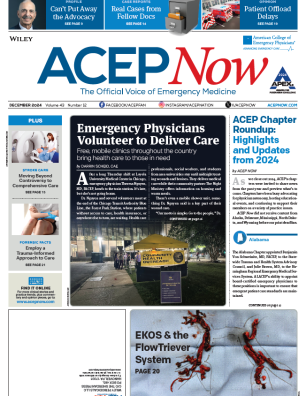Pocket ultrasound devices have arrived! With their price points set at less than $3,000, the era of personally owned ultrasound machines has begun. We finally have devices we can throw into our bags that upgrade easily, help us get images for “teleguidance,” transmit images wirelessly, and improve diagnostic accuracy via machine learning. Their scalability is enticing for many reasons, but there are important considerations when trying to integrate them into clinical practice. The 2018 Appropriate Use Criteria for Handheld/Pocket Ultrasound Devices produced by the ACEP Emergency Ultrasound Section and available at www.acep.org/patient-care/policy-statements/appropriate-use-criteria-for-handheldpocket-ultrasound-devices serves as a starting point when contemplating use of these systems.
Explore This Issue
ACEP Now: Vol 38 – No 07 – July 2019Who Should Buy It: Me or the Hospital?
The physician consumer is most protected when the hospital approves and purchases these devices, using the same processes that we use with our traditional cart-based machines. Advancing technologies bring increasing security fears and information technology (IT) challenges, particularly regarding HIPAA compliance, transmission of wireless data, and cloud storage. Purchasing decisions need to be made in conjunction with the vendors, department administration, IT and security, risk management, and clinical engineering departments. Emergency departments pursuing this technology often use hospital-encrypted phones or tablets. If these units are lost, tablets can be wiped of patient information quickly and the probes deactivated.
However, their relative inexpensiveness entices people to purchase their own devices for novelty and convenience. This may be fine for use in nonclinical educational settings, but bringing personal devices into clinical environments for either diagnostic or educational purposes without appropriate approval can lead to trouble, including HIPAA or other statutory or regulatory violations. The ACEP Emergency Ultrasound Section has heard accounts of early adopters being fired for using personal systems and encourages those interested to thoroughly explore the requirements with their facility prior to purchasing.
Are They Good Enough?
The image quality of these latest devices has improved dramatically from prior units, given advances in smartphone microprocessing and the ability to tweak software algorithms via application updates. However, the capabilities are not equivalent to traditional cart-based units that use more powerful processors. Images on smartphone devices can be fuzzy and grainy, and some functions will be limited. While most pathologies that emergency physicians are looking for should be discernible using tablet devices, subtle findings may not be fully visualized, and novices may overlook pathological clues. Tablet ultrasounds are not replacements for cart-based machines. Interested physicians should get a hands-on demo to assess appropriateness for their environments.
Pages: 1 2 3 | Single Page





No Responses to “What’s the Deal with Pocket Ultrasound?”